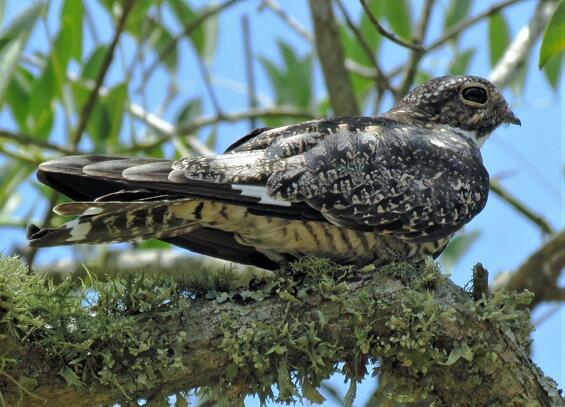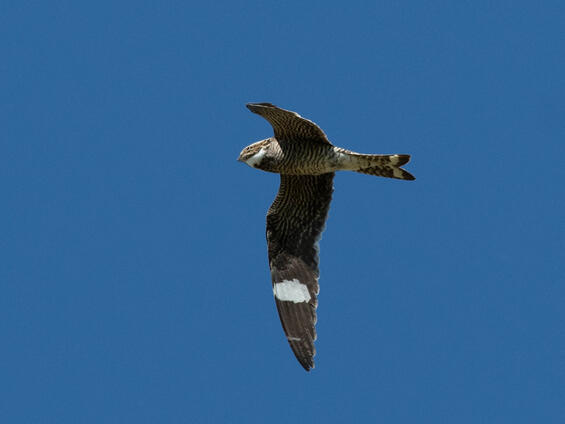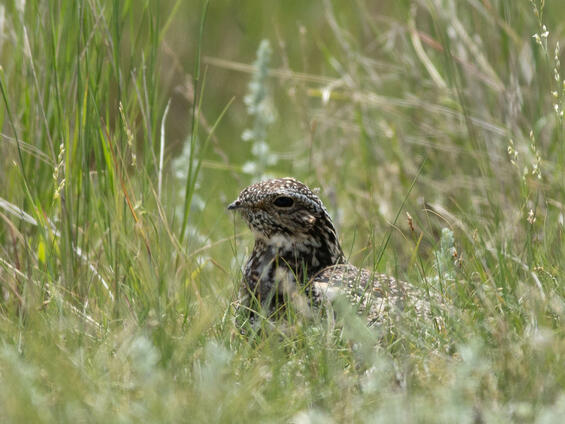- Scientific name: Chordeiles minor
Species of Greatest Conservation Need (MA State Wildlife Action Plan)
Description

Common nighthawk
The common nighthawk is an aerial insectivore most often seen in Massachusetts during its southern migration, when it passes overhead in loose flocks along river valleys in the last days of August. In flight it is a distinctive bird: approximately 23 cm long (9 inches) with long pointed wings marked with white wing bars, a fluttery but strong flight habit, and a sharp, nasal call often given in flight. When perched, common nighthawks rest horizontally with their legs and feet against the body. The bill barely extends beyond the feathers, and the eyes (when open) are large and black. Overall, the plumage is mottled earthtones, resembling the dry, bare ground that they typically roost and nest on.
Life cycle and behavior

Common nighthawks generally arrive in Massachusetts in mid-May, streaming overhead as singles or in small flocks. They are ground nesters, historically laying eggs in a scrape on dry ground in barrens, dunes and poor pastures. However, nesting in natural areas has not been documented in Massachusetts since the 1980s, and now most nesting occurrences are associated with gravel roofs in urban areas. The female selects the nest site and lays two eggs that she will incubate for 16-20 days. Chicks remain in the nest for 18 days, where they are fed regurgitated insects by both parents. Post-breeding, common nighthawks will form small to relatively large flocks as they move southward, following river valleys and hawking aerial insects. Common nighthawks winter in South America and the Carribean Islands.
Population status
Massachusetts Breeding Bird Atlas 1 surveys found a scattering of nighthawks all over the state, particularly in the Marble Valleys, the Lower Worcester Plateau, the Coastal Plains, and to a lesser extent the Cape and Islands. The only strongholds of the species during the late 1970s were the Boston Basin and the Connecticut River Valley, which together accounted for almost half of all occupied nighthawk blocks in Atlas 1. The Boston and Springfield metropolitan areas in particular had large concentrations of breeding nighthawks because a plethora of electric lights attracted an abundance of aerial prey and gravel rooftops offered suitable opportunities for nesting. During Atlas 2, only a handful of reports affirmed the bird’s presence in the state during the breeding season, and not a single nesting confirmation was submitted. In fact, the species’ footprint declined 70% between the Atlases, making them one of the most steeply declining birds in the Commonwealth.
Breeding Bird Survey data shows that the population of common nighthawk has experienced a strong decline in Massachusetts and throughout its range (range wide -2.2% annual decline, 1966-2011).
Distribution and abundance
Originally known as ground nesters in Massachusetts, historically common nighthawks occurred in moderate numbers in large pine barrens, coastal dunes, and occasionally on agricultural land across the state. However, the last documented ground nesting was documented in the barrens of Myles Standish State Forest in Plymouth (1982). Common nighthawks began nesting on flat gravel rooftops in the 1800s allowing them to thrive in urban areas for decades. By the 1950s, the majority of breeding occurrences of common nighthawks were associated with urban areas: Boston, Worcester, Springfield, Northampton, and Pittsfield. However, gravel roofs have largely been replaced by rubber, and as a result, the common nighthawk has nearly disappeared in the state.
Although there is just one relatively recently confirmed breeding location known in Massachusetts, there have been recent breeding season observations of nighthawks in dunes along the north shore, and annual courtship behavior between pairs in recently restored barrens (Muddy Brook, Hardwick) that suggests they may be again breeding in natural habitats in Massachusetts.
Habitat

Common nighthawks are ground nesters, and modern occurrences in Massachusetts are most often associated with gravel rooftops in urban areas. Natural nesting habitat, though not documented as being utilized in Massachusetts since 1982, includes large coastal dune systems, large barrens, and occasionally large patches of agricultural land. Migrating flocks of common nighthawks are often observed associated with river valleys where they hawk for insects on the wing.
Healthy habitats are vital for supporting native wildlife and plants. Explore habitats and learn about conservation and restoration in Massachusetts.
Threats
Specific reasons for the overall decline of common nighthawks in Massachusetts are not clear, but the availability of suitable nesting habitat is thought to be a primary factor. In urban areas, a movement away from gravel rooftops is to blame. Reforestation of barrens may play a role in the decline of natural breeding occurrences, as well as an increase in mesopredators in coastal areas. Another contributor may be declining insect populations and changes in insect community structures.
Conservation
Placing gravel pads in the corners of flat, smooth roofs has been suggested as a strategy for attracting breeding common nighthawks in urban areas. Managing large areas of existing or historic pine barrens with prescribed fire (and timber harvesting when necessary) may create appropriate conditions to attract breeding common nighthawks.
References
Breeding Bird Atlas Explorer (online resource). 2015. U.S. Geological Survey Patuxent Wildlife Research Center. <2015-02-15>. http://www.pwrc.usgs.gov/bba. Data compiled from: Massachusetts Breeding Bird Atlas 2007-2011
Brigham, R.M., J. Ng, R.G. Poulin, and S.D. Grindal. 2011. Common Nighthawk (Chordeiles minor), The Birds of North America Online (A. Poole, Ed.). Ithaca: Cornell Lab of Ornithology; Retrieved from the Birds of North America Online: http://bna.birds.cornell.edu/bna/species/213
Sauer, J.R., J.E. Hines, J E. Fallon, K.L. Pardieck, D.J. Ziolkowski, Jr., and W.A. Link. 2014. The North American Breeding Bird Survey, Results and Analysis 1966 - 2013. Version 01.30.2015 USGS Patuxent Wildlife Research Center, Laurel, MD
Veit, R.R, and W.R. Petersen. 1993. Birds of Massachusetts. Massachusetts Audubon Society, Lincoln MA.
Contact
| Date published: | April 4, 2025 |
|---|